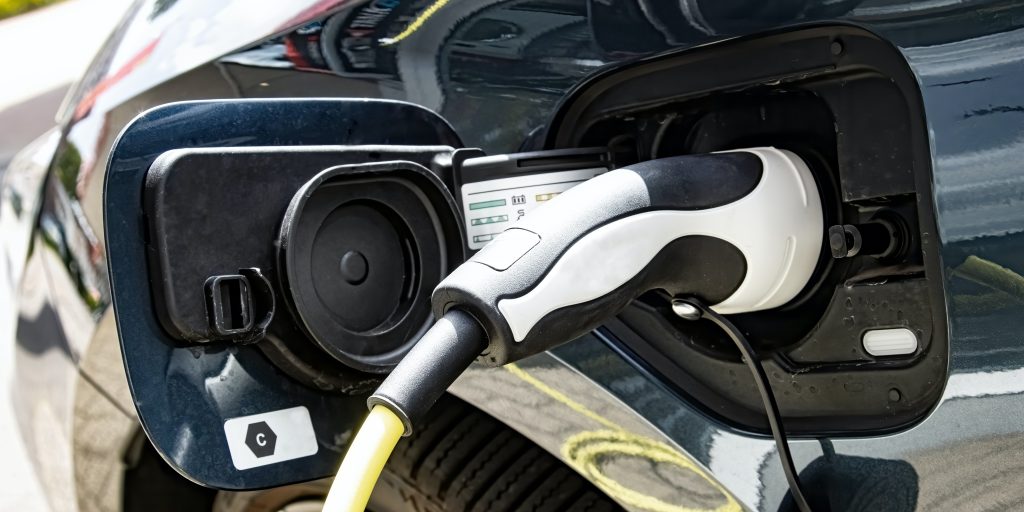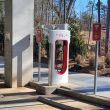Cities lay the groundwork for an adequate EV charging infrastructure
Work continues on building out the nation’s electric vehicle (EV) charging infrastructure. On June 9, the Biden Administration proposed new standards for a national EV charging network.
The administration’s goal is to build out a national network of 500,000 electric vehicle chargers along America’s highways and in communities. It is a key piece of the $1.2 trillion Bipartisan Infrastructure Law (Infrastructure Investment and Jobs Act). There are currently about 49,200 alternative fueling stations in the U.S., according to the U.S. Department of Energy.
The Energy Department, in collaboration with the U.S. Department of Transportation, is proposing new standards to make charging EVs convenient, reliable and affordable for all Americans, including when driving long distances. Without strong standards, chargers could be less reliable, may not work for all cars, or lack common payment methods. The new standards will help ensure motorists throughout the U.S. can use the network—no matter what car they drive or which state they are charging up their vehicles in.
But are half a million chargers enough? Maybe not, says Bill Policastro, vice president of grants and business development at Blink. “Some estimates show that the need for charging stations in the U.S will be in the millions to meet the growing demand for EVs.” Blink is a leading owner and operator of Fast Level 2 and Direct Current Fast Charging (DCFC) EV charging stations. The firm manufactures charging stations, connects them via the Blink Network, and partners with host locations to operate them.
Policastro says state and local governments are key partners in the expansion of the national EV charging network. “Blink has been awarded over $30 million in grant funding and RFP awards since January 2021 to build out strategic EV charging pipelines in states such as Ohio, Texas, Florida and Michigan.”
The Blink executive says cities have an important function to play as motorists switch to EVs. “Partnerships with municipalities to install public EV chargers are particularly important to mass adoption of EVs, especially for the millions of Americans who do not live in single family homes or have access to a garage.”
He adds that public chargers will play a key role in ensuring charging infrastructure is accessible to all. “For example, Blink Mobility operates the BlueLA EV car-sharing program in partnership with the Los Angeles Department of Transportation, and last year announced it is expanding to add 300 additional chargers in downtown Los Angeles and up to 200 EVs to make the service accessible to disadvantaged residents.”
Several West Coast cities, including San Jose, San Francisco and Los Angeles, are leaders in establishing EV infrastructure, says Celeste Frye, co-founder and CEO of Public Works Partners LLC, a WBE/DBE/SBE-certified planning and consulting firm. The company specializes in multi-stakeholder initiatives and building strong parterships across the nonprofit, government and private sectors.
Frye says one Golden State community has made a significant push for public charging infrastructure. “San Jose has launched a $14 million charging station construction project. The city will continue building charging stations amounting to nearly 1,500 new ports. Regarding funding, $10 million devoted to this project comes from the California Energy Commission with the city of San Jose contributing $4 million. The city has committed to building 25 percent of these stations in low-income and disadvantaged communities—a key initiative in ensuring equitable distribution of EV infrastructure.”
Frye cautions that the growing popularity of EVs requires that cities like San Jose expand their EV infrastructure. “Even leading the nation, the city only has 2.6 charging stations per 1,000 people. This infrastructure will be strained unless continued investment takes place as the market share of EVs continues to rise.”
Yes, more state and local governments are using cooperative contracts to acquire EV charging stations, says Barry Carr, director, business development—eMobility and electrical infrastructure at ABM. The company is a facility management provider and offers facility solutions. It provides a variety of services in each industry it serves, including governments.
“One of the more time-consuming components of scaling out EV charging platforms is the site-by-site RFP process, and cooperative contracts can greatly accelerate that process. Most states have their own procurement agencies, and EV charging manufacturers get their equipment listed on these contracts,” Carr explains.
He points to national cooperatives as a potential resource for EV infrastructure. TAPCO, for instance, offers EV charging stations through a cooperative contract with OMNIA Partners, Public Sector. TAPCO distributes Blink’s economical EV charging systems.
Local procurement officers and other city officials should reach out to their local utilities and charging infrastructure companies when they want to expand their EV infrastructure, says Matthew Alford, manager, markets and business development, eMobility at EY Americas. EY (Ernst & Young) is a worldwide professional services organization that provides services covering consulting, assurance, law, strategy, tax and transactions.
Those resources can point you in the right direction, Alford explains. “They will help you select the correct technology for charging, understand charging loads and power delivery, site planning and engineering, awareness of any rebates and incentives and select the correct rate to charge.”
Alford says city officials should also think about staffing of EV charging infrastructure within city-operated EV fleets. “In the future, three separate positions will merge for electric vehicle supply equipment (EVSE) fleets: fuel procurement, facilities maintenance and fleet operations.”
Local government officials, including procurement officers, should engage with relevant stakeholders early and often when considering installing EV charging stations and other EV infrastructure, says Stacy Noblet, ICF Climate Center senior fellow and vice president, transportation electrification at ICF. The company is a global advisory firm and digital services provider.
“EV charging infrastructure projects will be more likely to succeed if they involve the buy-in, collective experience, and assistance of a broad range of voices and perspectives. This includes other city agencies like municipal fleets, city energy managers, planning and sustainability offices, as well as organizations that are often external, like utilities, metropolitan planning organizations, EV user groups, Clean Cities coalitions, etc.,” Noblet says.
She adds that proper infrastructure siting is key. “No matter how fast the charging infrastructure build-out is, we can expect to remain in a ‘charger limited’ world for the near-term, where the lack of charging infrastructure could impede EV adoption, including for medium- and heavy-duty vehicles.”
Noblet says local procurement officers and other city officials need to be armed with a well-informed planning process and a data-driven approach for installing EV charging stations. “Data will only be more plentiful moving forward and municipalities should make the best use of this data to inform their charger deployments. If chargers are deployed in areas where they are needed the most, increased EV adoption is likely to follow.”
Recent American City & County posts show how the nation’s EV charging infrastructure is taking shape:
Cities steadily adding more EV chargers for public to use
Governments task procurement officers to lead the way in EV charging infrastructure
EVs are coming in a big way – Will charging infrastructure be ready?
Michael Keating is senior editor for American City & County. Contact him at [email protected].




















